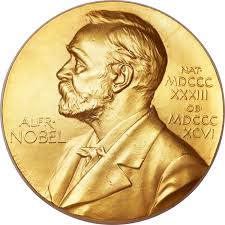The Nobel Prize in Physics is a yearly award given by the Royal Swedish Academy of Sciences for those who conferred the most outstanding contributions for mankind in the field of physics. It is one of the five Nobel Prizes established by the will of Alfred Nobel in 1895 and awarded since 1901; the others being the Nobel Prize in Chemistry, Nobel Prize in Literature, Nobel Peace Prize, and Nobel Prize in Physiology or Medicine. The first Nobel Prize in Physics was awarded to physicist Wilhelm Röntgen in recognition of the extraordinary services he has rendered by the discovery of the remarkable rays (or x-rays). This award is administered by the Nobel Foundation and widely regarded as the most prestigious award that a scientist can receive in physics. It is presented in Stockholm at an annual ceremony on 10 December, the anniversary of Nobel's death. Through 2017, a total of 111 Physics Nobel Prizes have been awarded to a total of 207 Physics Nobel Laureates (as John Bardeen has been awarded twice there are 206 individuals who have been awarded the Nobel Prize in Physics since 1901) and only two women have won the Nobel Prize in Physics: Marie Curie in 1903, and Maria Goeppert Mayer in 1963.
There is no other prize in the intellectual realm with the prestige of the Nobel Prizes. They also have a visibility that can hardly be compared to any other. In an age of science and technology in which we are gradually losing whole sets of values, fundamentally humanistic ones, the Nobel Prizes are one of our last bastions. We seek in them a reference, not only of excellence, but of honesty, enthusiasm, commitment to ideals, that inspires both laymen and professionals. Many of the winners were recognized among his peers as unique individuals, long before they were awarded the Prize. And afterwards they have continued to behave like people with great human qualities. That is why knowing about them (Nobel Laureates) and their contribution (awarded discoveries) towards science and technology can be a tremendous inspiration and example for the young students from all over the world. Of all the Nobel Prizes have a more fundamental character and there is a degree of truth associated with them and they all help build what we might call the “Great Humanity”. Their findings not only generate progress and allow society to develop, but also help us to know ourselves. Detailed knowledge about the laws and mechanisms governing Nature may have no immediate application, but make us aware of our own place in the Universe, help us be more modest, more aware of our environment.
The aim of this compilation is to present all the Physics Nobel prizes to the curious readers in a tabular form (easy to read and find) who are not only interested to know about the Nobel Laureates but also about the growth of physics concepts with time which have attracted the awards.
Some most interesting facts about Nobel Prizes:
- In the statutes of the Nobel Foundation it says: "If none of the works under consideration is found to be of the importance indicated in the first paragraph, the prize money shall be reserved until the following year. If, even then, the prize cannot be awarded, the amount shall be added to the Foundation's restricted funds."
- Posthumous nominations can't be made for Nobel Prizes. If during consideration, the nominee dies, his name is removed. But if a person dies after being announced as the winner, a posthumous award is given.
- More than three people can't share a Nobel Prize.
- The Curies (Marie and Pierre Curie) comprised a very successful 'Nobel Prize family'. Marie Curie herself was awarded two Nobel Prizes - In 1903, she along with Pierre Curie (husband) was awarded half the Nobel Prize in Physics. In 1911 she was awarded the Nobel Prize in Chemistry. One of Marie and Pierre Curie's daughters, Irène Joliot-Curie, was awarded the Nobel Prize in Chemistry in 1935 together with her husband Frédéric Joliot.).
- To date, the youngest Nobel Laureate in Physics is Lawrence Bragg, who was 25 years old when he was awarded the Nobel Prize together with his father in 1915.
- The average age of Nobel laureates, across all prize categories, is 59. But the oldest prizewinner was 90-year-old Leonid Hurwicz, who won the Economics Nobel (technically called the Sveriges Riksbank Prize in Economics Sciences in Memory of Alfred Nobel) in 2007. The youngest winner is Malala Yousafzai. She won the Peace Prize in 2014 when she was 17 years old.
- There is often a substantial delay between when a scientist makes a Nobel-worthy discovery and receiving the award—the average time varies from 20 to 30 years, depending on the award category. Sometimes the wait is even longer.
Father & son awarded the Nobel Prize in Physics:
William Bragg and Lawrence Bragg, 1915
J. J. Thomson, 1906 and George Paget Thomson, 1937
Niels Bohr, 1922 and Aage N. Bohr, 1975
Manne Siegbahn, 1924 and Kai M. Siegbahn, 1981

